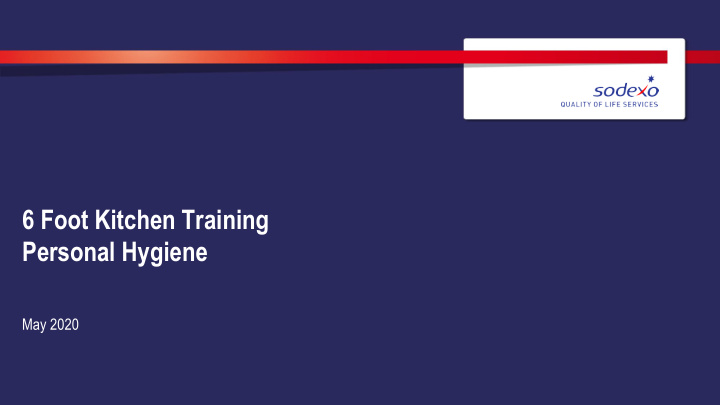



6 Foot Kitchen Training Personal Hygiene May 2020
Personal Hygiene (60 minutes) LEARNING OUTCOMES After this topic, learners will have an understanding of: Module I: 5 minutes § How to clean your car to prevent the spread of Coronavirus Module II: 10 minutes § Dirty cell phone statistics and proper cleaning Module III: 10 minutes § Personal hygiene basics Module IV: 20 minutes § Proper handwashing Module V: 10 minutes § What about my shoes? Quiz: 5 minutes
I. How to Clean Your Car to Prevent the Spread of Coronavirus Disinfectant wipes or soap and water work best to clean the inside of your vehicle. Spend extra time on the steering wheel. According to carrentals.com, a steering wheel can have four times the amount of germs found on an average toilet seat. Include the following areas: § controls for radio § door and center console armrests § voice control § display screen § cruise control § cupholders navigation cubbyholes § § gear selector lever air conditioner vents § § § turn signal indicator § door “grab handles” You use them more than you know!
II. Dirty Cell Phone Statistics & Proper Cleaning
III. Personal Hygiene- Back to Basics • Employees and managers who handle, prepare or serve food have no apparent illnesses (vomiting, diarrhea, fever, jaundice, sore throat with fever, infected open wounds or boils, etc.) and cuts, abrasions and burns on hands and exposed arms properly covered (i.e., bandage, finger cot, disposable glove)? • It is recommended that employees take their temperature each day prior to coming in to work. • Fingernails are well-trimmed and clean; no nail polish or artificial fingernails worn? • No jewelry (except smooth-surface rings / bands) during food production. • Hair and beard restraints are provided and worn by food-handlers during production of food items? • Employees wash hands before beginning / returning to work or when necessary during work. • Gloves • Hands are washed before putting on gloves. • Gloves must be changed before starting another job and when they are torn, dirty or contaminated. • Gloves must be changed when switching from raw food to ready-to- eat food. • Employees eating, drinking and personal items must be stored and/or consumed in a designated area away from food preparation, service and storage.
IV. Proper Handwashing
IV. Proper Handwashing- Video
V. Masks, Hand Washing, Social Distancing, But What About My Shoes? • Recent research suggests that SARS-CoV-2 can survive for extended periods of time on several different types of surface, ranging from metals and plastics to cardboard and cloth. However, these findings do not reveal how long viruses remain active on shoes. • If a person needs to visit the grocery store or go to work, choose one pair of shoes for leaving the house. When returning home, remove shoes before entering the house and store them in a separate area, such as a garage or entryway. • Consider the following guidelines for cleaning and disinfecting shoes: • Wipe the exterior surfaces and soles of the shoes with a disinfecting wipe. Soaking them in hot water and soap is another effective disinfection method. • Wash machine washable or cloth shoes using hot water (60–90°C, or 140–194°F) and detergent or soap. • If the machine has a sanitize setting, use it. • Dry shoes in a well-ventilated area. • Wear gloves when handling potentially contaminated objects, including when disinfecting shoes. Immediately throw disposable gloves away. • Always wash hands immediately after handling potentially contaminated objects and avoid touching the eyes, nose, and mouth.
QUIZ 1. Which part of the inside of your car has 4x the amount of germs as a toilet seat? a. Steering Wheel 2. What are the 3 ways to prevent your phone from spreading germs? a. Clean your phone daily b. Avoid sharing your phone c. Wash your hands frequently throughout the day 3. Where should employee food/drink and personal belongings be stored? a. In a designated area away from food preparation, service and storage. 4. How many steps are there to properly wash your hands? a. 11 5. What are the 3 best way to avoid cross contamination from your shoes? a. Wipe the exterior surfaces and soles of the shoes with a disinfecting wipe. b. Soak them in hot water and soap. c. Wash machine washable or cloth shoes using hot water and detergent or soap. 9
REMEMBE R
Recommend
More recommend